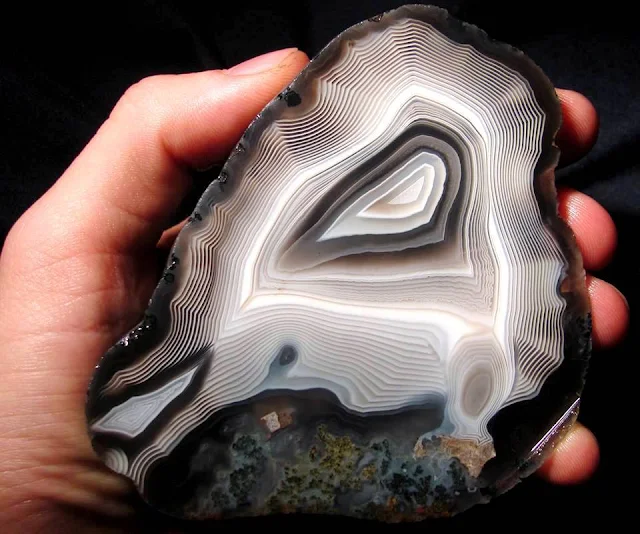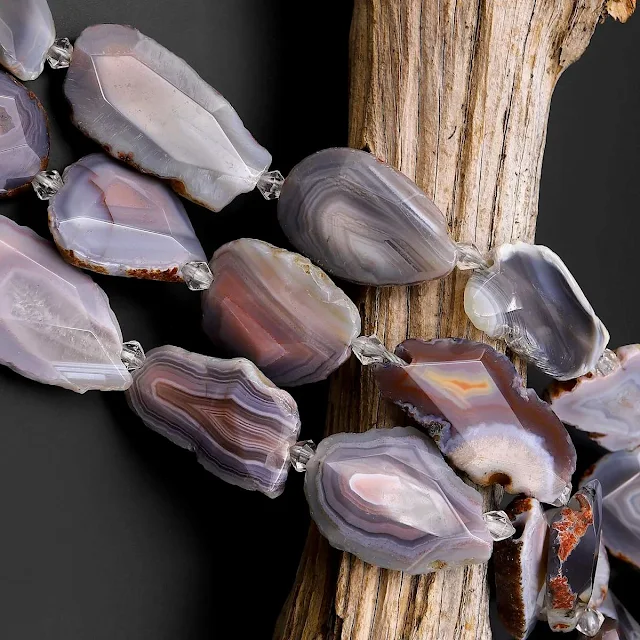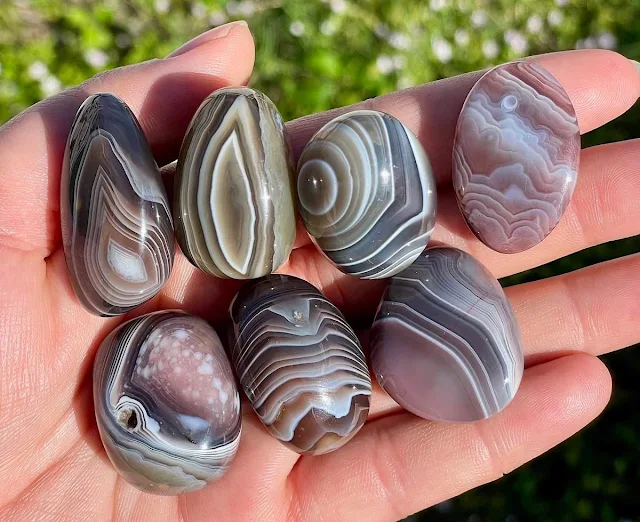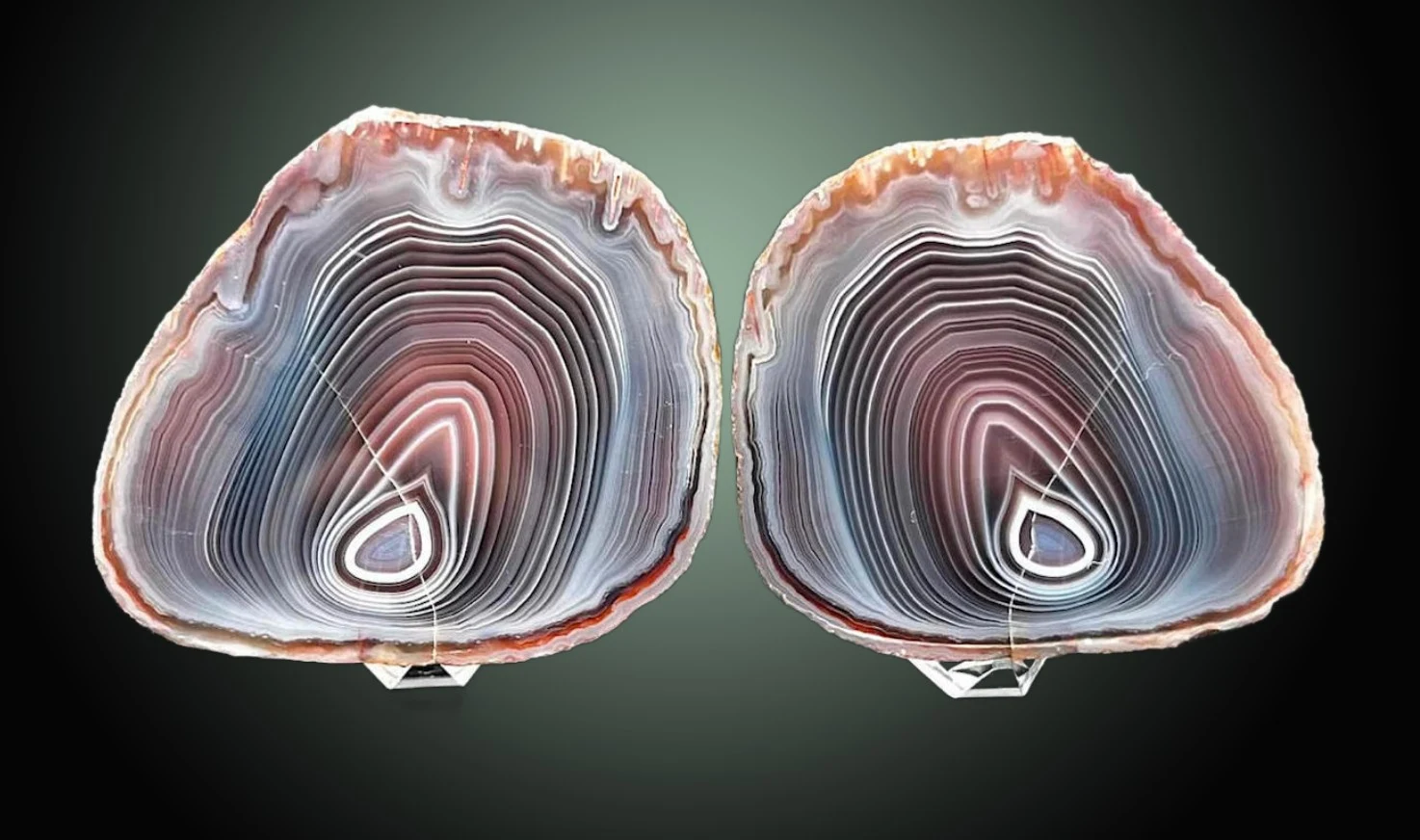Botswana Agate: Properties, Uses, Colors
Botswana Agate is a type of banded agate found in Botswana, Africa. It features distinctive banding patterns in colors like pink, gray, brown, and white. Popular in jewelry, it is believed to have metaphysical properties related to balance and protection. The stone is also used in decorative objects and lapidary work.
Botswana Agate is considered the national gemstone of Botswana and is a source of pride for the country.
Botswana Agate is a relatively rare gemstone, especially high-quality pieces with vibrant colors and intricate patterns. This rarity contributes to its value, making it a popular choice for collectors and jewelry enthusiasts.
 |
| Botswana Agate: Properties, Uses, Colors |
Botswana Agate Formation
Botswana Agate is formed through a process involving volcanic activity and mineral deposition. Here's a simplified explanation:
Volcanic Activity: Initially, Approximately 187 million years ago, volcanic eruptions in the African region created extensive lava flows. This lava contains various minerals, including silica. Within the solidified lava, pockets of gas became trapped, forming empty cavities.
Over time, fluids rich in silica (SiO₂) migrated through the surrounding rock, primarily sourced from volcanic or groundwater activity. As these fluids cooled and underwent pressure-induced crystallization within the cavities, layers of microcrystalline quartz (a polymorph of SiO₂) were deposited sequentially.
Banding Formation: The distinctive banding in Botswana Agate is believed to be caused by the deposition of different minerals and impurities during the cooling process.The specific color and pattern of each agate layer are determined by the presence and concentration of trace minerals and impurities within the silica-rich fluids.
Agate Formation: Agate forms within cavities or voids in rocks, often created by gas bubbles during the volcanic activity. Over time, as the silica-rich solution permeates these cavities, it cools and solidifies, forming concentric layers of different colors and textures, creating the characteristic banded appearance.
Concentric banding patterns and characteristic "eye" formations within the agate are a result of these complex interactions and variations in the deposition process.
Mineral Inclusions: The various colors in Botswana Agate are attributed to the presence of different minerals and impurities, such as iron and manganese, which contribute to the stone's diverse and appealing color palette.
- Iron oxides: Red and orange hues are primarily attributed to iron oxides like hematite (Fe₂O₃) and limonite (FeOOH).
- Manganese oxides: Black and gray shades are often caused by manganese oxides like pyrolusite (MnO₂) and manganite (MnO(OH)).
- Other minerals: Additional minerals like chalcedony (SiO₂) and jasper (SiO₂ with various impurities) can contribute white, blue, and green colors.
This process of layer formation is incredibly slow, taking millions of years to produce the agates we know and love. As the surrounding rock erodes over time, these hidden treasures are eventually revealed, waiting to be discovered and admired.
 |
| Botswana agate rough |
Botswana Agate Properties
Composition: Botswana Agate, like all agates, belongs to the chalcedony family, a microcrystalline variety of quartz. Its primary composition is silicon dioxide (SiO2), often intertwined with trace amounts of iron, manganese, and aluminum, which contribute to its enchanting color palette.
Color: A mesmerizing palette ranging from soft pink and gray (the most common), earthy browns, delicate lavender to rich purple, dramatic black with white or gray accents, and even rare fiery red.
Luster: Botswana Agate boasts a waxy to vitreous luster, meaning it catches light with a soft, pearly sheen or a glassy brilliance.
Crystal System: Its crystal system is trigonal, characterized by a triangular arrangement of its atoms.
Streak: White
Hardness: 6.5 to 7 on the Mohs scale, making it relatively durable for everyday wear and tear.
Cleavage: Botswana Agate does not have any distinct cleavage planes, meaning it doesn't break along predictable lines.
Crystal Form: Usually found in massive, meaning it forms large, irregular chunks, or banded forms, sometimes as nodules or geodes.
Density: This gem has a density of around 2.60 to 2.65 g/cm³, making it slightly heavier than water.
Transparency: Translucent to opaque, depending on the thickness and presence of inclusions.
Fracture: Conchoidal
Specific Gravity: 2.60 – 2.65
Solubility: Insoluble in water and most common acids.
Magnetism: Non-magnetic
Fluorescence: Can exhibit weak fluorescence under longwave ultraviolet light, with colors ranging from white to blue-white.
Pleochroism: Weak, with slightly different color intensities depending on the viewing angle.
Refractive Index: 1.544 – 1.553
Inclusions: Common inclusions include quartz crystals, agate moss, and chalcedony spherules. These inclusions can add unique beauty and character to the stone.
 |
| Agate from Bobonong Subdistrict, Central District, Botswana Credit: Joshua LeCram Ritter |
Botswana Agate Occurrence
The vast majority of Botswana Agate occurs, as its name suggests, in Botswana, nestled in the heart of southern Africa. Its primary deposits are found in the central district, primarily around the town of Bobonong. Additional occurrences are reported in the northeastern region along the Motloutse River and southwest of Bobonong in the Serowe area.
 |
| Botswana Agate Beads |
Botswana Agate Uses
Botswana Agate is primarily used in the creation of jewelry and decorative items. Here are some common uses:
- Jewelry: Botswana Agate's attractive and distinctive banding patterns make it a popular choice for crafting beads, cabochons, and pendants. Jewelers often incorporate it into necklaces, bracelets, earrings, and rings.
- Decorative Items: The unique patterns and colors of Botswana Agate make it suitable for decorative items. Craftsmen use it to create carvings, figurines, and ornamental objects.
- Lapidary Work: The stone is often used in lapidary work, where artisans cut, shape, and polish it to create various items. This can include carvings, cameos, and other artistic creations.
- Collectibles: Given its unique appearance and origin, Botswana Agate is sought after by collectors. Some individuals collect specimens for their aesthetic value or metaphysical properties.
- Metaphysical and Spiritual Practices: Some people believe in the metaphysical properties of stones, including Botswana Agate. It is thought to possess qualities such as balance, harmony, and protection. Individuals may use it in meditation, energy work, or as a talisman.
It's important to note that while Botswana Agate is appreciated for its aesthetic qualities and believed metaphysical properties, any claims related to its healing or spiritual benefits are not scientifically proven. As with any gemstone, its uses can vary based on personal preferences and beliefs.
 |
| Botswana agate tumbles |
Apricot Agate
Apricot Agate rare variety of Botswana Agate. The defining feature of Apricot Agate is its soft pink color, often resembling the rich hue of a ripe apricot. Shades can range from a pale blush to a deeper salmon, sometimes even exhibiting subtle orange and yellow undertones.
Botswana Agate Meaning
Botswana Agate holds various meanings in the realm of metaphysics and alternative beliefs. Let's delve into the symbolic and metaphysical significances this breathtaking gemstone carries:
1. Grounding and Balance:
The layered formation of Botswana Agate symbolizes grounding and stability. Its earthy tones, particularly the browns and pinks, evoke a connection to the natural world, anchoring us in the present moment. This grounding energy is believed to help combat feelings of anxiety, fear, and uncertainty.
2. Emotional Harmony:
The mesmerizing swirls and patterns of Botswana Agate are often interpreted as representations of emotional balance. The harmonious blend of colors encourages inner peace and tranquility, promoting emotional stability and resilience. This meaning makes it a popular choice for those seeking greater harmony and emotional equilibrium.
3. Intuition and Higher Consciousness:
The vibrant colors and intricate patterns of Botswana Agate are sometimes associated with the stimulation of the third eye chakra, associated with intuition and higher consciousness. It's believed to enhance one's ability to tap into a deeper understanding of themselves and the world around them, promoting spiritual growth and awareness.
4. Protection and Security:
Botswana Agate, particularly the black varieties, is traditionally considered a stone of protection. Its grounding energy is believed to create a shield against negativity, both physical and emotional. Some even hold the belief that it protects against harmful energies and psychic attacks, offering a sense of security and stability.
5. Creativity and Inspiration:
The unique and captivating patterns of Botswana Agate are often seen as muses for creativity and inspiration. Its beauty is believed to spark imagination and stimulate artistic expression, making it a valuable companion for artists, writers, and other creative individuals.
 |
Apricot Agates |
6. Transformation and Self-Discovery:
The journey of Botswana Agate from volcanic rock to stunning gemstone symbolizes transformation and personal growth. Its layered formation is seen as a reflection of our own journey, with each layer representing a stage of growth and evolution. This meaning resonated with those seeking self-discovery and personal transformation.
It's important to remember that the meanings attributed to Botswana Agate are rooted in belief and symbolism rather than scientific fact. However, their influence on people's perception and interaction with this stone cannot be dismissed. Whether you resonate with its grounding energy, find inspiration in its patterns, or simply appreciate its breathtaking beauty, Botswana Agate offers a unique opportunity to connect with something deeper than just a physical object.
 |
| Agate geode splite from Bobonong Subdistrict, Central District, Botswana |
Botswana Agate is more than just a beautiful gemstone; it's a captivating window into Earth's history, culture, and the power of nature's artistry. Its unique beauty and fascinating story make it a truly special treasure.
Read also:
Eye Agate: Properties, Uses, Formation
Blue Lace Agate - Properties, Occurrence, Uses

%20(1).webp)






